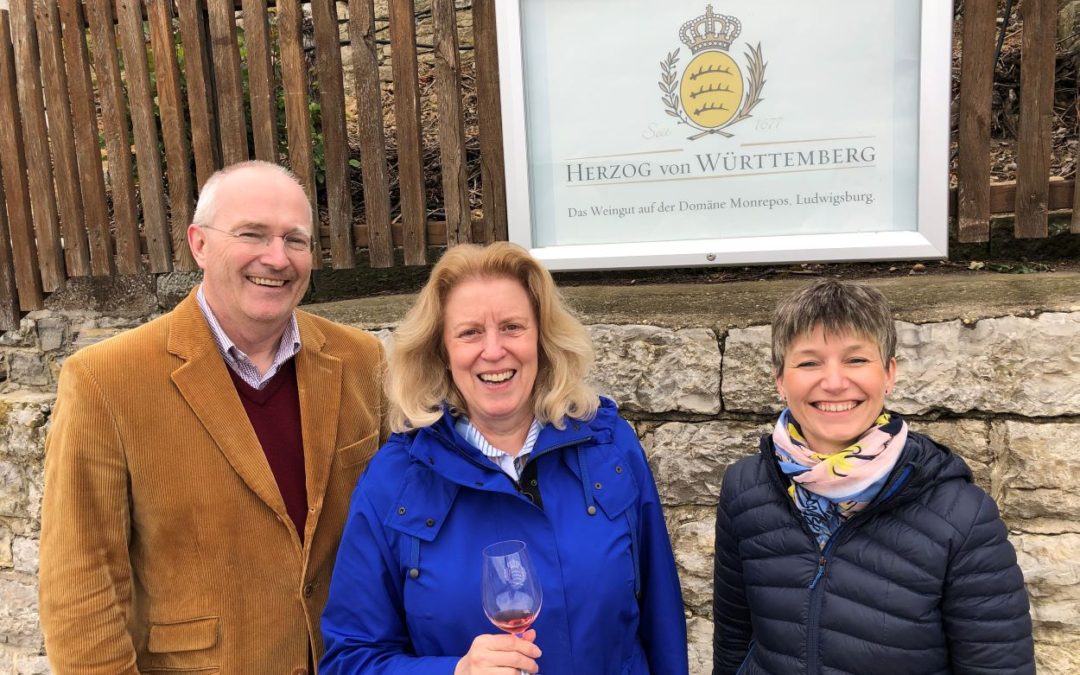A visit to the wine region of Württemberg in southwestern Germany will quickly dispel with two myths about German wines: that they are white and that they are all sweet. In this region, which forms part of the federal state of Baden-Württemberg, over 70 percent of the grape varietals are red and most of the top quality wines are dry. On my recent visit, I also found other interesting Swabian quirks that makes this a fun place for travel.
I started my visit in Stuttgart, the state’s capital and the sixth largest city in the country. Founded in the 10th century, unfortunately much of it was destroyed during the Second World War. While gorgeous historic buildings are scarce, it does have an impressive pedestrian-only main shopping street, Königstraße and many parks and gardens often called “das Grüne U” (the green “U”) because they are strung together in a U-shaped form around the city centre.
My hotel Althoff Hotel Am Schlossgarten, overlooked the 600 year old Schlossgarten (castle gardens) near the northern facade of the new palace where one might start a two hour walking circuit through the parks perhaps stopping at a Biergarten (beer garden) to refresh. I only had time for a short stroll along Königstraße as dinner beckoned at the hotel’s wine tavern, Weinwirtschaft Franz Keller.
It was white asparagus season and several dishes of this spring specialty were on the menu. To say it’s highly popular is an understatement: during this period from mid-April to mid-June, Germans consume approximately 70,000 tons of this juicy pale vegetable. It’s believed that the roots of German asparagus (spargel) are found somewhere around Stuttgart, where it has been grown since the 1500s. In the beginning, it was planted exclusively for the royal and ducal Baden-Wurttemberg courts which is why spargel was nicknamed ‘royal vegetable’ and ‘white gold.’ My white gold came with bearnaise sauce, boiled potatoes and Wienerschnitzel (a thin, breaded, pan-fried veal cutlet).
Stuttgart is most famous for its automotive industry – both Porsche and Mercedes-Benz have their headquarters in Stuttgart and both have car museums. I have visited the museums in the past and highly recommend them. The super modern and architecturally cool Mercedes Museum celebrates the automobile invented by Carl Benz in 1886. It houses more than 160 vehicles ranging from the oldest automobiles ever built to legendary racing cars and futuristic research vehicles which form the centrepiece of the permanent exhibition covering a total of 16,500 square metres in twelve rooms. https://www.mercedes-benz.com/en/art-and-culture/museum/
My focus however this trip was on the area’s wine. The next day I headed with two colleagues to visit a few of the wineries. We munched on fresh brezel, Stuttgart’s big doughy soft pretzels smeared with butter, on the way. First stop was Dautel in Bönnigheim, a winery with a 500 year history. Fourteen generation wine maker, Christian Dautel met us and took us through a tasting of wines including an impressive oak aged chardonnay (they were the first to plant the varietal here in the eighties), excellent dry riesling and spätburgunder (pinot noir) and concentrated, spicy lemberger (a dark red varietal also known as blaufränkisch).
From there we went up steep slopes covered with terraced vines to the vineyards of Herzog von Württemberg. The wine-growing tradition of the house of Württemberg dates back to the 13th century and today the Duke Michael, (Herzog means duke in German) represents the family at the winery. He told us a bit of the history of his illustrious royal family (his mother was a princess and his grand grand uncle a king) as we sipped refreshing cool trollinger.
The red grape trollinger accounts for about a fifth of total wine production in the region and over 98% of plantings of trollinger in Germany are in Württemberg. It makes a blush-like red that’s light in both colour and style. Cheaper versions can be slightly sweet but the best are dry and fresh on the palate.
Down the steep slopes below was the Neckar River which runs through the heart of the Württemberg wine-growing region from its upper course near Tübingen to its confluence with the Rhine near Heidelberg. The house of Württemberg also owns a hotel and restaurant at their Monrepos estate, set on an English garden-style park spanning 250 hectares. We drove there next to check into their Schlosshotel Monrepos. www.schlosshotel-monrepos.de/en/the-estate
Over a fine meal we tasted wines from the estate as well as from Graf von Bentzel-Sturmfeder represented by Count Kilian (Graf is German for count), Weingut Drautz-Able and Kistenmacher-Hengerer Weingut. All were members of the VDP (Verband Deutscher Prädikatsweingüter) a national German association founded in 1910 of about 200 producers committed to top quality wine production. (Their standards are higher and stricter than the government ones.)
From Count Kilian we learned two thirds of his wine production is red and mainly spätburgunder (pinot noir) though he also makes samtrot (a silky pinot meunier mutation), and lemberger.
The next day we started with a visit and tasting at the very impressive facilities of the Research Centre of Viticulture and VDP Staatsweingut Weinsberg, the oldest wine school in Germany opened in 1868 – and offering free tuition for all students both national and foreign.
At lunch at the home of Markus Drautz we were served maultaschen, a traditional Swabia pasta stuffed with minced meat, onion, spinach and spices. According to folklore, the monks of the Cistercian Monastery in Maulbronn developed this meal to eat during various fasting periods hiding the meat in the pocket’s dough so that God could not see their secret filling. With the meal Markus poured incredible old vintages of his Drautz-Able wines so we could see how long and well they aged including long-cellared champagne method sparkling wines.
Our last stop was at Graf Neipperg, a royal family which served the Hapsburg monarchy for over 300 years in Austria and is credited with bringing lemberger to Germany. We tasted six versions of this big red, all quite full and ripe, yet firm with good acidity and structure.
It’s not just maultaschen that tucks away delicious surprises in Württemberg.

